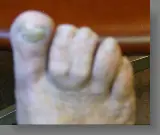syndactaly
AUTHOR: Marc Mitnick DPM home --> syndactalywebbed toes
WHAT IS SYNDACTALY
Webbing of the fingers and toes is called syndactaly. It refers to the connection of two or more fingers or toes. Webbing usually only involves a skin connection between the two areas, but in rare cases may involve the fusion of bones. This is known as simple vs. complex webbing. What occurs here is a failure of two or more adjacent digits to fully segmentalize during development.
Webbing occurs once in every 2000-2500 births and is three times more common in males than females. Webbing may be discovered during an examination of an infant or child. In its most common form, it is seen as webbing between the 2nd and 3rd toes. This form is often inherited and is not unusual.
Syndactyly can also occur along with other birth defects involving the skull, face, and bones. In fact webbing of the toes may be associated with over 300 syndromes.
The web connections usually run up to the first joint of the finger or toe, but may run the entire length. Bilateral involvement is found in 50% of patients.
"Polysyndactyly" describes both webbing and the presence of an extra number of fingers or toes. The "location" of the extra digit goes a long way in determining treatment, if treatment is necessary.
In the foot three types of webbing are seen.
Type 1 (zygodactyly), partial or complete webbing of the second and third toes; hands may also be affected.
Type 2 (synpolydactyly), syndactyly of the lateral two toes and polydactaly of the fifth toe in the syndactyly web.
Type 3, associated with metatarsal fusion.

|
TREATMENT FOR SYNDACTALY
Surgical intervention for simple syndactaly of the foot is rarely indicated as the webbing causes minimal loss of function of the toes, it is more of an issue with the fingers. Perhaps the number one reason for surgical intervention is cosmetic disapproval by the patient, rather than loss of function, at least in the foot.
Simple syndactaly involves skin grafts to separate the toes. If the two adjacent bones are fused separation becomes more difficult because many times there is only a single tendon and vascular system supplying the two toes and once separated obviously the two toes would no longer be able to share the tendon and blood supply.
In instances where you have a polydactyly (extra digit), if it occurs on the medial or lateral side of the foot, then amputation of the extra digit is the treatment of choice, assuming once again the extra digit does not share a common blood supply with the adjacent digit.
In patients that exhibit central polydactyly where the extra digit is in the middle of the foot, it becomes more difficult to determine which digit to surgically remove. However, removing the extra "inside" digit does not narrow the foot in any way and reconstruction of the middle of the foot in a cosmetically acceptable fashion can be very difficult.
REFERENCES
Children's Hospital of Philadelphia


Recent Articles
-
Vitamin D impact on health
Feb 06, 23 07:17 PM
Researchers are suggesting that the effectiveness of Vitamin D in fighting and preventing disease is predicated on a persons body mass index (BMI). The thinner the person the greater the positive impa… -
Foods to speed up healing
Feb 01, 23 02:41 PM
One of the best ways to help yourself heal faster after surgery is to eat well. Getting the proper nutrition will provide your body with the essentials it needs to promote healing. Here is a suggestio… -
Cancer and Type 2 Diabetes
Jan 25, 23 04:52 PM
An article revealing that older type 2 diabetics have a higher incidence of cancer then non-diabetics. It is suggested that cancer may surpass CVD as the number one cause of death in older diabetics. -
Does glucosamine or MSM reduce arthritis pain?
Jan 22, 23 01:41 PM
A good review of the possible benefits to taking glucosamine, chondroitin or MSM for arthritis. Always beware of the possible side effects of over the counter supplements. -
shin splints
Jan 18, 23 05:12 PM
A great review on the various causes of shin splints, along with treatment options. -
Whats new in skin cancer?
Jan 15, 23 08:32 PM
A presentation of newer skin protection combinations in an effort to better protect the skin from the hazards of sun exposure. -
Causes and risk factors of warts
Jan 14, 23 05:02 PM
A good review of the causes of warts and protective measures you can take to prevent developing them. -
Do chronic wounds need to be dressed daily?
Jan 11, 23 02:18 PM
Because of supply chain shortages as well as staffing shortages particularly during the pandemic, many institutions extended the time between dressing changes for chronic wounds. Is this really the be… -
Food choices that raise your risk of type 2 diabetes
Jan 08, 23 10:07 AM
A good review of how blood sugars can become elevated and the harm that can do. Certain food groups have a tendency to raise your blood sugars and should be avoided. -
Outcome stats from Scarf bunionectomy
Jan 03, 23 03:04 PM
The Journal of Foot and Ankle Surgery recently reported a meta analysis of outcomes in 1583 Scarf bunionectomies that met their inclusion criteria. Adverse events did not seem to be any better or wors…